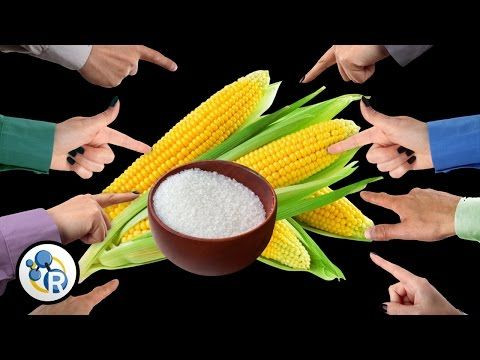Sugar vs. High Fructose Corn Syrup: How Each Breaks Down In The Body

Not all sweet tooth cravings are created equal. Table sugar and high fructose corn syrup may taste similar to the tongue, but as soon as you swallow, they're processed differently in your body — one of these sugars is worse for you than others. The battle of the two simple monosaccharide sugars, glucose and fructose, has led nutritionists and doctors alike to explain the biological differences in two of the most popular food and drink ingredients worldwide.
When you consume sucrose, or white table sugar, it breaks down into the body as half fructose and half glucose. Fructose is a sugar naturally occurring in many fruits and vegetables. However, when it's processed manufacturers add it to a wide variety of soda and fruit-flavored drinks. When it metabolizes in the body, it processes through the liver, cues insulin to release, and stimulates the production of leptin — a hunger hormone that controls energy intake.
One of the most infamous and controversial sucrose replacements is the manmade sweetener known as high fructose corn syrup (HFCS). It’s made by milling corn down until it turns into corn starch, which is then further processed with water and bacterial and fungi-derived enzymes that break down into short chains of glucose or corn syrup. Add another bacterial enzyme to convert the glucose and you finally have HFCS, which is significantly sweeter than glucose.
Glucose, on the other hand, is considered the body’s energy source. It’s also called blood sugar because it circulates throughout the body and can be used immediately for energy or stored in muscle cells or the liver as glycogen for later use. When it’s digested, glucose provides satiety signals to the brain that fructose cannot provide because it isn’t transported to the brain, telling the body it’s satisfied with what it just consumed. But because glucose isn’t as sweet as fructose, and because of continued consumption, the modern palate has become accustomed to higher levels of sweetness.
When the government placed domestic production quotas and foreign import tariffs on sugar in 1977, the industry turned to HFCS for a cheaper sweetening alternative to sugar, according to Diabetes Health. Between 1970 and 2000, people consumed 30 percent more fructose than they ever had before.
Take a look at the nutrition labels on the back of common grocery store products and there’s a good chance HFCS is ubiquitously listed on everything from soda to whole wheat bread. Ever since researchers first synthesized it for commercial use in the late 1960s, it has spread like a contagion throughout the processed food industry, according to a 2011 case filing by the Western Sugar Cooperative. Between 1970 and 1990, there has been more than a 1,000 percent increase in commercial use.
Long-term consumption of sugary drinks can double the risk of diabetes, and part of that risk is due to the excess weight gained from sugar-calories, according to Dr. Walter Willett, the chair of the nutrition department at the Harvard School of Public Health. According to a study published in the American Society for Clinical Nutrition while HFCS has “become a favorite substitute for sucrose in carbonated beverages, baked good, canned fruits, jams and jellies, and dairy products … HFCS constitutes a major source of dietary fructose.”
Published by Medicaldaily.com



























